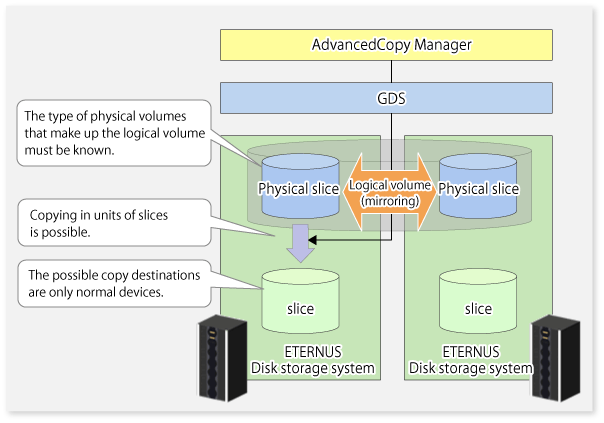SDX objects of GDS can be replicated in units of slices where replication is performed without GDS Snapshot.
This operation however requires that the physical disks that make up the GDS logical volume be specified.
For details on GDS, refer to the "PRIMECLUSTER(TM) Global Disk Services User's Guide (Solaris(TM) Operating System)".
Figure 6.50 Replication operation in units of slices

Note
If mirroring between boxes is enabled and copying to the original volume by OPC is required in the event of a box failure, both mirrored systems must be replicated. In such cases, the required capacity of the replica volume is not the size of the logical volume but the size of the physical volume.
The SDX objects that can be used for operations in slice units are as follows:
Single volumes
Non-layered mirror volumes
You can determine if the volume being used is the single, mirror, stripe, concatenation, or switch volume type by executing "sdxinfo -e long". (Check the value in the TYPE column in the line displayed for the volume in the OBJ column.)
[Volume object type attribute]
single: Single volume (operation possible)
mirror: Mirror volume (operation possible)
stripe: Stripe volume (operation not possible)
concat: Volume in a concatenation group (operation not possible)
switch: Switch volume (operation not possible)
When specifying a name in the AdvancedCopy Manager command, use the following name format that combines a logical volume name and an AdvancedCopy Manager device name. Refer to "PRIMECLUSTER GDS SDX objects" for details.
/dev/sfdsk/<class-name>/dsk/<volume-name>:<device name where volume is constructed>
For notes on configuring the replication operation, refer to "9.1.5.2 Notes on SDX object operations (replication management)".
Replication with the copy destination volume of a mirror slice is not supported.
Consequently, if either the original volume or replica volume is a mirror slice, you can perform replication only from the mirror slice to a physical slice.
To copy data to a mirror slice, use the "dd" command. Copying must be executed for all mirror slices that make up the logical volume.
To perform the replication operation with a Managed Server and obtain information about a subordinate device of the Managed Server, you must register the server.
For details on how to fetch the device information, refer to "6.4.4 Fetching device information on a Managed Server".
Register the mirror slices that make up a mirror volume of GDS as replication volumes.
# /opt/FJSVswsrp/bin/swsrpsetvol /dev/sfdsk/CLS1/dsk/VOL1:c1t0d1 /dev/sfdsk/CLS1/dsk/VOL2:c1t0d2 swsrpsetvol completed # |
# /opt/FJSVswsrp/bin/swsrpmake /dev/sfdsk/CLS1/dsk/VOL1:c1t0d1 /dev/sfdsk/CLS1/dsk/VOL2:c1t0d2 FROM=/dev/sfdsk/CLS1/dsk/VOL1:c1t0d1, TO=/dev/sfdsk/CLS1/dsk/VOL2:c1t0d2 swsrpmake completed #
States of the objects in replication creation
Replication can be performed when the SDX object that makes up the relevant logical volume is in one of the states listed below. If the object is in any other state, replication cannot be performed. (AdvancedCopy Manager checks the state of the SDX object by using the sdxinfo command of GDS/SafeDISK.)
The state of the mirror volume is ACTIVE or STOP.
The state of the physical disk is ENABLE.
The state of the mirror slice is ACTIVE or TEMP.
Replication pre-processing and post-processing
Pre-processing and post-processing scripts are not executed when a slice of the SDX object is in the TEMP state.